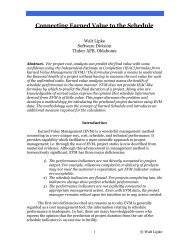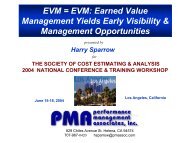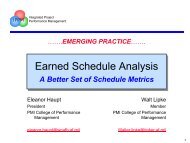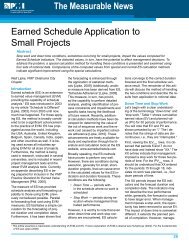Earned Schedule: A Breakthrough Extension to Earned Value ...
Earned Schedule: A Breakthrough Extension to Earned Value ...
Earned Schedule: A Breakthrough Extension to Earned Value ...
You also want an ePaper? Increase the reach of your titles
YUMPU automatically turns print PDFs into web optimized ePapers that Google loves.
EVM Strengths<br />
Since the EVM method was first published as the Cost <strong>Schedule</strong> Control System Criteria (CSCS/C) by the United<br />
States Air Force in 1967 it has become widely recognised as a very valuable project management and control <strong>to</strong>ol<br />
particularly, in a his<strong>to</strong>rical context, for very large complex acquisition contracts. EVM uniquely integrates cost,<br />
schedule and technical performance information in a manner which provides quantitative project performance<br />
information on the current status of the project as well as providing predictive information on future cost<br />
performance based on the his<strong>to</strong>ric project performance achieved <strong>to</strong> date.<br />
The application of EVM, predominantly on very large-scale United States Defense Department acquisition programs<br />
has been heavily researched over with the findings of this research summarised in<strong>to</strong> the “EVM Body of Knowledge”<br />
(Fleming 1999). These research efforts typically focused on the behaviour of the EVM cost indica<strong>to</strong>rs and<br />
predic<strong>to</strong>rs. Significant research was conducted, principally by Dr David Christensen and associates in the 1990s and<br />
early 21 st century, see Christensen 1993a, 1993b, 1995, 1998, 1999, 2002a and 2002b.<br />
EV<br />
CPI =<br />
AC<br />
PV<br />
BAC<br />
$<br />
EV<br />
SPI =<br />
PV<br />
SV<br />
CV<br />
AC<br />
EV<br />
EVM Limitations<br />
Time<br />
Exhibit 1 – <strong>Earned</strong> <strong>Value</strong> Basics<br />
While EVM has many very significant achievements in quantitatively expressing and analysing project cost<br />
performance, this success has not extended <strong>to</strong> schedule performance. Reasons for the lack of corresponding schedule<br />
success includes:<br />
• The EVM schedule indica<strong>to</strong>rs are, contrary <strong>to</strong> expectation, reported in units of cost rather than time.<br />
Because cost is the unit of measure, the schedule indica<strong>to</strong>rs are counterintuitive and require a period of<br />
familiarization before EVM users and project stakeholders become familiar with them.<br />
• Because EVM schedule indica<strong>to</strong>rs are expressed in units of cost, comparison with the time based network<br />
schedule indica<strong>to</strong>rs (e.g. the critical path (CP) calculated end date) is very difficult<br />
• The much more serious issue whereby the EVM schedule indica<strong>to</strong>rs always return <strong>to</strong> unity at project<br />
completion. The EV always equals the final PV, the BAC. Therefore the SV always returns <strong>to</strong> zero and<br />
SPI always returns <strong>to</strong> one irrespective of duration based project delay. The schedule indica<strong>to</strong>rs also fail for<br />
projects which continue <strong>to</strong> execute beyond the planned completion date.<br />
Over time EVM practice and research efforts have focused primarily on cost because these “quirks of algebra” with<br />
the EVM schedule indica<strong>to</strong>rs are well known and unders<strong>to</strong>od by experienced EVM practitioners. While the schedule<br />
indica<strong>to</strong>rs are available, they are not relied upon <strong>to</strong> the same extent as the indica<strong>to</strong>rs for cost. The resultant project<br />
management impact from the behaviour of the EVM schedule indica<strong>to</strong>r issues is that cost and schedule analyses of<br />
project status and performance have become disconnected. Cost analysts view the EVM cost reports and indica<strong>to</strong>rs<br />
while schedulers update and analyse the network schedule. For large projects and programs, these separate skills<br />
may be segregated and the respective analyses not reconciled.<br />
© Kym Henderson Page 2 of 10<br />
Originally published as a part of 2007 PMI Asia Pacific Global Congress Proceedings – Hong Kong








